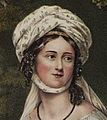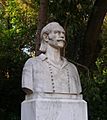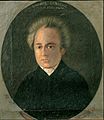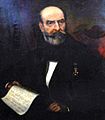Greek War of Independence facts for kids
Quick facts for kids Greek War of Independence |
|||||||
|---|---|---|---|---|---|---|---|
| Part of Wars of Independence | |||||||
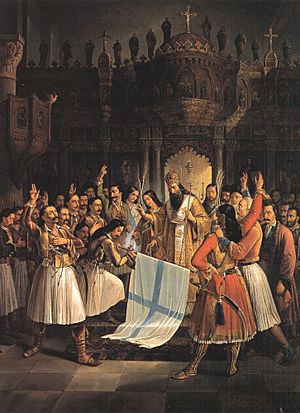 Germanos blessing the flag at Agia Lavra. Oil painting, 1865. |
|||||||
|
|||||||
| Belligerents | |||||||
| Commanders and leaders | |||||||
The Greek War of Independence (1821–1829), also commonly known as the Greek Revolution, was a successful war by the Greeks who won independence for Greece from the Ottoman Empire. Muhammad Ali Pasha sent his son Ismail with an army and a fleet to help fight the Greeks and the Greek Christian revolutionaries asked for help from European Christians. A fleet of the United Kingdom, France and Russia destroyed the Ottoman-Egypt fleet in the Battle of Navarino. After a long and bloody struggle, independence was finally achieved, and confirmed by the Treaty of Constantinople in July 1832. The Greeks were thus the first of the Ottoman Empire's subject peoples to be accepted as an independent sovereign power.
Images for kids
-
Portrait of a Greek armatolos by Richard Parkes Bonington (oil painting, 1825–1826, Benaki Museum)
-
House of Filiki Eteria on Greek Square in Odesa
-
Alexander Ypsilantis crosses the Pruth, by Peter von Hess (Benaki Museum, Athens)
-
Declaration of the revolutionaries of Patras; engraved on a stele in the city
-
Statue of Theodoros Kolokotronis, Nafplio
-
Jean-Pierre Boyer, President of Haiti. Haiti was the first state to recognise the Greek independence.
-
The Reception of Lord Byron at Missolonghi by Theodoros Vryzakis
-
Letter of Alexander Ypsilantis to Emmanouel Pappas, dated 8 October 1820
-
Bust of Emmanouel Pappas in Athens.
-
Konstantinos Kanaris during the Revolution
-
"The burning of the Ottoman frigate at Eressos by Dimitrios Papanikolis" by Konstantinos Volanakis
-
Dionysios Solomos wrote the Hymn to Liberty, which later became the National Greek anthem, in 1823.
-
"The burning of the Turkish flagship by Kanaris" by Nikiforos Lytras.
-
The sortie of Missolonghi by Theodoros Vryzakis (1855, oil on canvas, National Gallery of Athens).
-
"Karaiskakis landing at Phaliro" by Konstantinos Volanakis
-
Portrait of Muhammad Ali Pasha (by Auguste Couder, 1841, Palace of Versailles), whose expedition to the Peloponnese precipitated European intervention in the Greek conflict.
-
The Naval Battle of Navarino by Ambroise Louis Garneray (1827).
-
General Maison meeting Ibrahim Pasha in Navarino in September 1828 (by Jean-Charles Langlois,1838, Palace of Versailles).
-
Map showing the original territory of the Kingdom of Greece as laid down in the Treaty of 1832 (in dark blue)
-
"Grateful Hellas" by Theodoros Vryzakis
-
Nikolaos Mantzaros' most popular work is the music for Hymn to Liberty, whose first and second stanzas became the national anthem in 1865
See also
 In Spanish: Guerra de independencia de Grecia para niños
In Spanish: Guerra de independencia de Grecia para niños



